Book Reviews: Technical, Scientific, & Engineering Writing
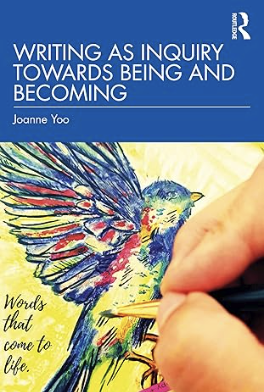
Writing as Inquiry Towards Being and Becoming: Words That Come to Life
Joanne Yoo. New York, NY: Routledge. 2025. 188 pages, including index.
Index Terms — academic inquiry, academic writing, writing, writing process
Reviewed by Michelle Gardner (mrswtgjr@gmail.com)
According to the back-cover copy, Joanne Yoo’s Writing as Inquiry Towards Being and Becoming: Words that come to life is “suitable for students and scholars of creative and qualitative inquiry who are interested in the writing process and how it shapes our identities as researchers in education, the social sciences, and communication studies.”
The book is suitable for those already immersed in or curious about qualitative inquiry and who want to explore the more creative dimensions of their work. It might also interest writers pondering the philosophical and emotional foundations of their craft.
If that describes you and you’re open to this reflective and exploratory approach, Writing as Inquiry Towards Being and Becoming is a provocative read.
Yoo offers a contemplative perspective on academic and creative writing as a process of personal and professional transformation. In the context of qualitative and arts-based inquiry, this book challenges traditional assumptions about what academic writing is and what it could become.
She uses narrative, theory, and poetic reflection to illustrate her points. While my own purpose in professional writing is practical and transactional, Yoo is incorporating deeply personal, philosophical, and spiritual aspects. Her approach rewards introspection over deliverables.
The book does not present a method, framework, or checklist in the way many professional communication texts do. Instead, Yoo invites the reader into a space of inquiry where writing is a vehicle for transmitting knowledge and a generative act of becoming.
In the “Becoming through crafting” chapter, readers get imagery of words that evoke the senses. “The vivid impressions made by visceral words reveal how knowledge is experiential and derived from our multi-sensory bodies” (p. 91). “Artisans undertake this dialogical approach to being and becoming by working with their materials to bring new creations to life” (p. 91). “Writing to inquire is about becoming. We harmonise the mind, body and heart to harness its vitality and to become whole. The joy experienced from such wholehearted and playful exploration keeps me on this path of crafting a grammar of being” (p. 110).
We learn in chapter 3 that pragmatism “limits the world to what is measurable, whilst dreams reveal the truth of things by encompassing the unknowable and mysterious” (p. 65).
The chapter starts with a story about a Buddhist monk who had nightmares about being ravaged by a tiger. His uncle assured him it was only a dream, so “[t]o end the tiger’s reign of terror, he only needed to see it for what it was and to wake up” (p. 46). The monk was held captive by his illusion and the newfound clarity set him free.
This story held a mirror up to Yoo’s struggle with academic writing. She moved beyond mainstream journals to “intimate and vibrant forms of academic writing that were deeply impactful. The vitality of these texts injected a new energy into [her] work, shattering the illusion that academic writing must be objective” (p. 46).
To help readers explore a particular concept of writing, Yoo provides activities at the end of every chapter. Building on the dream concept, the activities include:
- Dream writing – storyboard your dream and write how you feel about constructing a desired outcome of the dream
- Writing fast and improvisation – write about something you’d like to realize in your life
- Entering the liminal through opposites – mind map tensions in your life and write expressively about how you are managing one of them
- Harnessing the power of daydreaming – reflect on the significance of a daydream and write about your emerging thoughts and emotions
- Keeping a dream journal – look for a pattern or recurring symbols, people, or events
- Seeing through a multiplicitous gaze – explore the richness of multiple perspectives
The end-of-chapter activities are meant to encourage creative play that reveals novel solutions to various problems. They offer a nice blend of writing, sketching, and introspection that helps participants understand and articulate their experiences. They require concentration and commitment so that readers move beyond passive consumption.
Coming from the B2B world, where every sentence is engineered to get a result—open an email, click a link, book a meeting—it took me a while to acclimate to Yoo’s expansive writing and contemplativeness. She doesn’t rush to conclusions; she circles around ideas and allows ambiguity to linger. That might frustrate readers, especially those looking for immediate takeaways or clear answers. But if you can sit with the uncertainty, there are rewards in the process.
Writing as Inquiry Towards Being and Becoming isn’t a how-to guide; it’s a book about writing that helps us become who we are—professionally and personally—through the act of inquiry. It’s an invitation to slow down, reflect, and consider writing as a way of being in the world. If you’re willing to meet it on its own terms, it will reward you with a renewed sense of purpose in your writing practice.
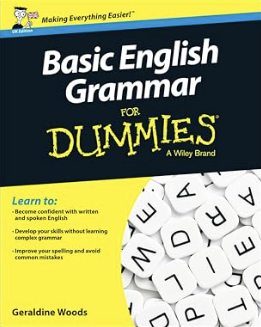
Basic English Grammar Workbook for Dummies
Geraldine Woods. Hoboken, NJ: John Wiley & Sons, Inc. 2025. 287 pages, including index.
Index Terms—basic English grammar, business writing, student writing, writing style
Reviewed by Ann Marie Queeney, Former Society for Technical Communication Senior Member (linkedin.com/in/ann-marie-queeney-13b50b62)
It is not often that a discussion of basic English grammar is described as informative and entertaining. Geraldine Woods, a Grammarian and author of more than fifty books, has written a clear, thorough, and engaging book on the topic.
As the title implies, this is not an exhaustive study of English grammar. Woods writes, “…I focus on the information you need to improve your grasp of standard English” (p. 1). She has intentionally kept the explanations “…clear, simple, and short” to encourage busy readers’ use of the workbook (p. 4). Woods’ companion book, Basic English Grammar for Dummies, 2nd edition, provides “…more detailed explanations and additional examples” (p. 4).
Rather than a rigid approach to grammar use, she guides readers in understanding the nuances and appropriateness of their choices. Woods elaborates, “I explain the rules of Standard English, but I also tell you when you can bend or break them in casual situations” (p. 1). This approach is practical and reflects how we use language.
Woods’ Basic English Grammar Workbook for Dummies is applicable “…whether you have spoken English all your life or you’re learning the language now” (p. 1). While the use of “basic” in the workbook’s title may deter experienced writers, Woods reinforces the need for lifelong learning of grammar by reminding us, “Language mirrors people’s experiences and understanding of the world. Because people never stop changing, language doesn’t either” (p. 21). A timely example is the changing use of the pronoun “they,” which has caused debate and confusion among writers. Woods provides a thorough exploration of the topic and gives practical advice on its usage.
I was glad to see that Woods also includes students in her book’s audience as the content is relevant for secondary and college students. Her experience teaching “every level of English from 5th grade through adult writing classes” (“About the Author”) enables Woods to share information pertinent to a student audience in Chapter 15, “Writing at School and at Work,” and in general, her conversational writing style and creative, succinct exercises would appeal to a young audience.
Woods divides the workbook into five parts, beginning with Part 1, “Mastering the Basics” which covers audience and purpose and “…the building blocks of language—the parts of speech…” (p. 2). Part 2, “Creating Correct Sentences”, covers the elements of a sentence followed by Part 3, “Perfecting Punctuation and Capitalization.” Part 4, “Grammar in Action” applies standard English to common situations readers will find in a business or school setting. I found Woods’ guidance regarding texting, emailing, and posting (and potential legal ramifications) especially useful. With the ubiquitous use of social media, it is easy to blur the distinction between writing in a personal, informal style and the standard English used in formal, often hierarchical business and academic settings. Part 5, “Getting the Details Right” covers such topics as common writing mistakes and a deeper dive into verbs and pronouns.
The chapters’ concise, consistent organization helps readers understand and practice the grammar rules. Woods begins topics with a brief explanation of the rule, followed by exercises that allow users to apply what they learned. Each chapter ends with a “Calling All Overachievers” section where readers complete exercises covering the entire chapter. Answers (with thorough explanations) to all exercises are conveniently found at the end of each chapter. Besides the workbook’s exercises, users have free 1-year access to online quizzes of the rules covered in the workbook.
Woods also employs formatting techniques to facilitate use of the workbook. She uses conventions (bolding, underlining, and italicizing) to help readers focus on the content she is discussing and icons to guide readers. For example, a checkmark icon signals the exercises section of the chapters. She explains the conventions, icons, and chapter organization in the “Introduction” section.
While each chapter builds on the previous content, users can easily personalize the workbook by choosing to complete the chapters in chronological order or selecting topics of interest. Woods offers a helpful time management tip for using the workbook. She suggests that users select a chapter that interests them and complete exercises in the “Calling All Overachievers” section as a pretest to gauge their understanding. The results will show rules they have already mastered or areas that require study.
Woods is clearly enthusiastic and knowledgeable about her topic. She has accomplished quite a feat, communicating often complex, dry information in a clear, concise, and friendly writing style as well as staying away from the use of formal terminology. Rather, she proves her deep knowledge of basic English grammar with clear, concise explanations and creative examples that shows why a rule is important.
Basic English Grammar Workbook for Dummies accomplishes its goal of creating confident, proficient writers of Standard English.

Steven Weinberg: A Life in Physics
Steven Weinberg. New York, NY: Cambridge University Press. 2025. 264 pages.
Index terms — cosmology, theoretical physics
Reviewed by Julie Kinyoun (jjshamon@gmail.com)
To an outside observer, the world of physics might seem mathematical, complex, dry, and dull. That view will quickly change upon reading Steven Weinberg’s memoir of his early education, research in quantum physics, committee work on military defense, and his political advocacy for the Superconducting Super Collider. Interspersed in his description of this period of his life are his anecdotal observations about people, places, and events that are unique to his perspective as a physicist. He also includes in this memoir his witty and ironic side observations that show an astute sense of humor. It is only unfortunate that he passed away shortly after writing this first installment of his life, missing the last twenty plus years before his death in 2021. Thus, this volume was compiled and finished by his wife and other experts; she/they added editorial final touches and photos, where appropriate.
Among other early influencing factors in his decision to study physics as a career was a book about Robert Oppenheimer, Los Alamos atom-bomb scientist, in which Weinberg realized that Oppenheimer was a well-rounded man as well as an accomplished physicist. “I saw that you didn’t have to renounce the world when you took on the vocation of theoretical physics” (p 5.)
Somewhere in Weinstein’s work teaching general relativity and struggling with questions in quantum mechanics, he started writing up his course notes for textbooks first geared for scientists and then later for laypeople. He also became involved in work advising the United States government on issues related to military defense.
He humbly suggested that his invitation to join the JASON group of defense consultants was due to his existing security clearance (given to all employees at his work) and his residence in Berkeley, California, but it is obvious that the overarching reason for his involvement was his academic background and qualifications. He stayed part of this group for about ten years advising different administrations on issues like submarine warfare, methods to block supplies for the Vietnam War, and strategic balance with the Soviets.
In the fall of 1967, he completed the work that would later earn him the 1979 Nobel Prize in physics. Ironically what eventually led him to his Nobel Prize winning discovery was his realization that “I was working on the wrong problem” (p. 99). Ultimately, he compiled a theory of elementary particles that turned out to be the “key to formulation of the modern Standard Model of elementary particles and would gain me the Nobel Prize” (p. 99).
His complex theory is best summarized by this statement, given as the introductory remark for his physics talk at the Royal Swedish Academy of Sciences, two days before he accepted the Nobel Prize. “Our task in physics is to see things simply, to understand a great many complicated things in a unified way, in terms of a few simple principles” (p. 168). He then explained that the Standard Model can be “seen as a consequence of the symmetries of the theory, together with the requirements of simplicity that is necessary for infinities to be eliminated by renormalization of a limited number of numerical constants, including masses and couplings” (p. ??).
In the 1980s and 1990s, Weinberg was heavily involved in the unsuccessful attempt to build a high energy particle accelerator in the United States that would confirm some of the predictions of the Standard Model and answer other questions about dark matter, signs of super symmetry, or other unexpected results. The project was successful in obtaining initial support from politicians and even spent about a billion dollars on digging a tunnel in Texas and preparing magnets. Congress pulled the funding in favor of other scientific projects. Weinberg diplomatically explains his disappointment with the events leading up to the project’s demise, but even with his polite excuses for the failings of it, he is obviously dismayed and a bit concerned about the future of physics research in the United States. “As an American, I am sorry nevertheless to see that our country is no longer in the forefront of experimental research on elementary particles. One consequence is that American students will either not work on experimental high-energy physics or, if they do, will tend to study and work abroad….The good theorists were here for our country when the national defense required them to be at Los Alamos. Will they be here, or abroad, should the national defense again have need of them?” (p. 226).
Throughout the book, Weinberg reflects on many fulfilling personal relationships both in physics and in his social life. A notable one that seems to cross into both arenas is with his wife who was truly his companion, both socially and professionally. Although she appears in his memoir throughout the entirety of the book, he comments specifically on a professional contribution she made early to his career. “At this time, Louise literally saved my life….She advised me to have nothing further to do with Bernie’s world, if I wanted to get anything done in physics” (p. 112).
This memoir, a review of the life and work of Steven Weinberg, is not only a review of twentieth-century physics and its struggles, triumphs and discoveries, it is a work that reflects a man of humility, integrity, fierce hard work, and struggle to discover the mystery of life through the study of physics.
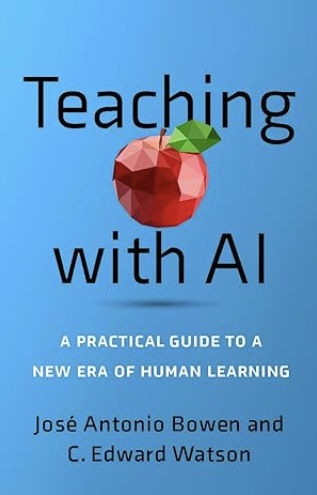
Teaching with AI: A Practical Guide to a New Era of Human Learning
José Antonio Bowen and C. Edward Watson. Baltimore, MD: Johns Hopkins University Press. 2024. 270 pages, including index.
Index Terms—AI in education, curriculum development, cheating policies, pedagogical tools, teaching strategies
Reviewed by Gregory Zobel, Associated Professor, Western Oregon University.
José Antonio Bowen and C. Edward Watson’s Teaching with AI: A Practical Guide to a New Era of Human Learning engages readers. Unlike many recent books about artificial intelligence (AI), Bowen and Watson’s book is not a collection of past blog posts. Rather, this work is a research-driven educator’s guide that addresses pedagogical questions and concerns. This book emphasizes teaching in higher education by using many prompts, activities, and scenarios that are also applicable for secondary education teachers.
The authors divide the book into three sections—thinking, teaching, and learning with AI—with each section having four chapters. They do not spend too much time on AI basics or general social impact. Readers new to AI, but interested in teaching with AI, would do well to first read Ethan Mollick’s (2024) book, Co-Intelligence, which sets a foundation which helpfully informs Bowen and Watson’s Teaching with AI.
The authors address the biggest concerns about AI in education such as cheating with AI, creating AI policies, and what does “good” work look like. This book is unlike most LinkedIn or YouTube content about AI and education. The book is clear, persuasive, and robust, as well as includes diverse prompts for different assignments, contexts, and learning activities that fill dozens of pages.
Bowen and Watson address the hype that “everyone is cheating.” They identify many areas where faculty and educators have lots of work to do. In short, revising and redeveloping curricula, assessments, in-class activities, and assignments. Bowen and Watson offer clear guides, suggested prompts with iterations, and plentiful potential ideas.
This book is best suited for several audiences. First, educators training future technical communicators in undergraduate and graduate environments will find this book useful given all the connections to prompting, assignments, and engagement as well as course redesign and academic policies. For those not working in education but who are still new to AI, “Section 1: Thinking with AI,” is one of the best available. Supporting that are multiple, practical examples and discussions of prompt creation, specificity, and iteration. Finally, “Part III: Learning with AI” is useful. Examples about gaining feedback and roleplaying with AI (Chapter 9) as well as Writing and AI (Chapter 11) provide important perspectives, questions, and practices. These two chapters appear particularly useful for independent contractors or new practitioners seeking to improve their own work through practice and simulation. Given the Teaching with AI’s price, it seems easy to justify the purchase even if the reader only plans to skim parts of the book and excerpt or focus on a few key chapters.
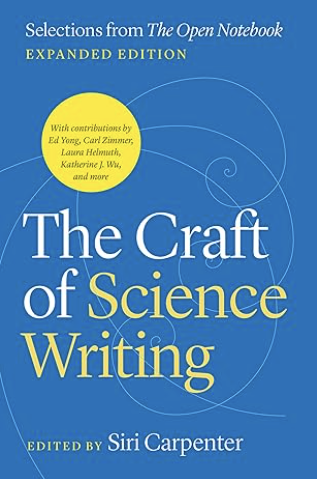
The Craft of Science Writing: Selections from The Open Notebook, Expanded Edition
Siri Carpenter, ed. Chicago, IL: University of Chicago Press. 2024. 368 pages, including index.
Index Terms—craft articles, interview techniques, reporting tips, science writing
Reviewed by Bonnie Denmark, Professor, Western Connecticut State University.
The Craft of Science Writing: Selections from The Open Notebook, Expanded Edition, is a curated collection of craft articles for established and aspiring science journalists. Editor Siri Carpenter has put together a well-balanced compilation that offers practical advice from experienced science writers.
She divided the book into five fundamental areas of science writing: “Who Is a Science Journalist and How Do You Become One?” “What Makes a Science Story and How Do You Find One?” “How Do You Report a Science Story?” “How Do You Tell Your Story?” and “How Do You Build Expertise in Science Writing?” Each part comprises eight to nine articles with tips on finding and vetting sources, conducting interviews, writing beginnings and endings, making a pitch, reading primary sources, avoiding pitfalls, and other pertinent topics, all toward the goal of reporting on science clearly, engagingly, and accurately—and getting published.
In this corner of journalism, there is a dearth of specialized training. The Open Notebook comes to the rescue, and not only with this book. Readers can find all the essays and interviews in the book among the vast archives on The Open Notebook website (theopennotebook.com), established as a nonprofit in 2010 to provide skill-building resources and opportunities for science writers to connect with a world of colleagues.
The Craft of Science Writing is an excellent craft book written by a diverse community of writers for a diverse community of readers. I used the 2020 edition with my university science writing students and look forward to using this updated edition in the classroom. The expanded edition includes all the original content plus nine additional essays to further help writers present science in the most accessible and accurate way. The new articles round out the collection with guidance on working with sensitivity readers, eradicating ableist language, critically evaluating claims, tapping into social media for sources, and basing writing on data, among other subjects. Carpenter conveniently numbered the articles in this expanded edition, which is a small detail that makes the book easier to use in the classroom.
Visit theopennotebook.com for a comprehensive library of resources for science journalists. Meanwhile, this curated subset in one tidy volume serves as an ideal base text for those new to science journalism and provides expert tips even for seasoned professionals.
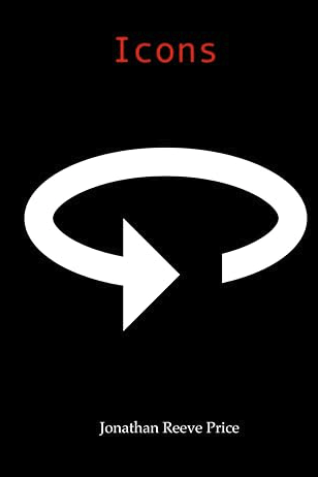
Icons: Poems
Jonathan Reeve Price. Albuquerque, NM: The Communication Circle. 2024. 126 pages.
Index Terms—AI in education, curriculum development, pedagogy, teaching with AI
Reviewed by Jeanette Evans
Thinking about how to evaluate communication through graphics can be of interest to those of us in the technical communication community as we can use and evaluate such means of communication in our own work. Jonathan Reeve Price explains in Icons: Poems how the elements of the computer icons we use today and when these graphical elements were created. They were part of what Apple used in their early graphical user interfaces. Price reflects on how these icons today have become part of our culture and everyday digital life.
The author takes each of 100 icons and has authored a poem about each one. We typically do not stop to think so deeply about icons. So, it is fun to see Price’s poetic take on each icon. He has a striking enlargement of each icon—one per page—with his poetic musing where he thinks about such things as name and function. Price’s musings can be funny, insightful, and thoughtful. The icons discussed in Icons: Poems are 100 of the 3,000 icons available from Google’s Material Design set. An example is (p. 26), which has a poem in Icons: Poems, that points out in part how versatile the icon is as it can be a noun, verb, glyph, and much more.
In looking at each icon, Price asks questions such as whether the icon is beautiful. He also evaluates how effective the icon is in explaining what the shape is meant to express and even questions how humans connect with each other. In our own work, we can ask ourselves related questions about the graphical devices we are using. Such questions and musings can be fun and useful.
Anyone involved in communicating information graphically could benefit from reading Icons: Poems to gain insight into how to use, develop, and evaluate a graphical element. The poetry in this book lets us think more deeply about how human beings want to and can communicate and connect. The poetry made me think of the expression—a picture is worth a thousand words—as I thought about how an image or icon can express more than a verbal description alone. Icons: Poems also made me think about the icons in a church and how through these icons, humans try to “persuade that spiritual being to act on our behalf” (p. 15). I asked myself if the people who picked the word “icon” to depict elements in a graphical user interface were right in picking that word. I suppose it was not a bad choice as I could not produce anything better.It was especially notable to me that Price is an STC Fellow with a fabulously interesting background. “He quit the art world to join Apple Computer in 1982, where the introduction of MacPaint was a life-changing event for him. He created a style guide used for many years by technical communicators—How to Write an Apple Manual, later published in several editions under the title, How to Communicate Technical Information,” as explained at the https://www.jonathanreeveprice.com/ site which also notes how Price “has taught information architecture, technical writing, content development, and databases at New York University, Rutgers, New Mexico Tech, and as an adjunct professor, through the University of New Mexico, as well as online through the University of California, Santa Cruz.” Wow! Wow! Wow!

